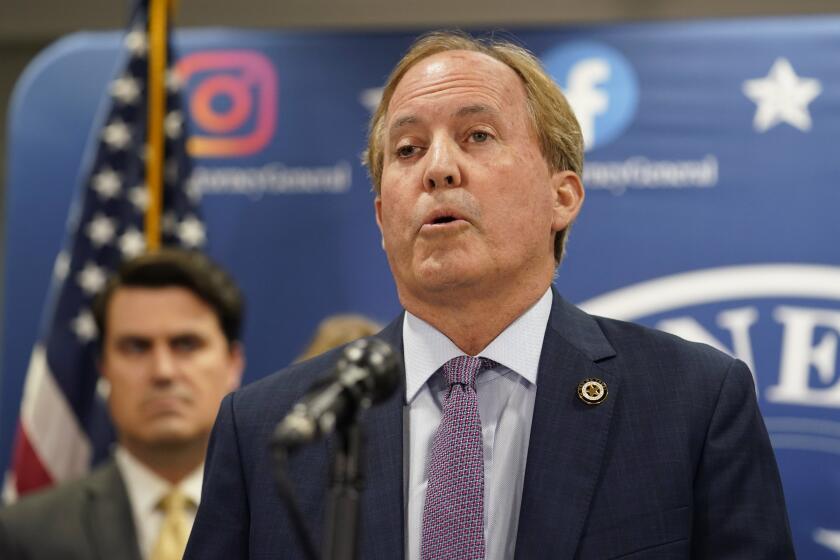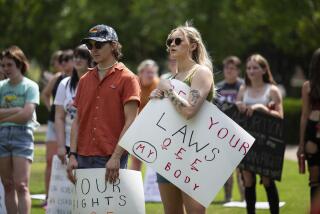Column: A reminder that the GOP used to be the pro-abortion party, and Democrats the anti party

American political memories are notoriously short, so it’s unsurprising that our perception of abortion politics dates back only to 1973.
That’s the year, of course, that the Supreme Court handed down its landmark decision in Roe vs. Wade, which safeguarded abortion rights in the U.S. for 49 years until a right-wing majority on the Court overturned it in 2022. Everything before 1973 is consigned to the mists of prehistory.
That’s a shame, because a longer perspective would tell us much about politics in America and explain how the abortion issue was drafted into a partisan culture war — indeed, became the chief weapon against social equality in the hands of conservative politicians and their evangelical Christian partners.
This really is about women’s status in society, controlling women’s behavior and the limits of that behavior.
— Former Planned Parenthood President Faye Wattleton
“Abortion was not a partisan issue at that time,” according to the journalist and historian Linda Greenhouse. “It was a medical problem, it was a social problem.”
Greenhouse’s words are taken from “Reversing Roe,” a 2018 documentary on the prehistory and aftermath of the Supreme Court decision, available on Netflix.
Get the latest from Michael Hiltzik
Commentary on economics and more from a Pulitzer Prize winner.
You may occasionally receive promotional content from the Los Angeles Times.
“Other issues have been as divisive—civil rights comes to mind,” author Sue Halpern observed in her review of the documentary for the New York Review of Books — “but none has been as definitional.”
So it will help to take a quick journey over the pre-Roe landscape. Here are the landmarks:
In the decades prior to Roe vs. Wade, abortion was broadly illegal in the U.S. Women seeking abortions for their physical and psychological health — these were known as “therapeutic abortions” — often had to appear before hospital committees of physicians, mostly male, to get permission. Sometimes it was granted on the condition that the patient agree to permanent sterilization after the procedure.
The situation underscored the severe racial and economic divides in America of that era. White women in general could muster the wherewithal to obtain safe abortions, sometimes by traveling as far as Sweden for the purpose.
In Texas, maternal mortality is soaring. Blame the antiabortion movement
Black women typically had no such options. They and others without access to willing doctors perished at a horrifying rate from self-abortions or operations performed in “dark, dingy apartments,” the documentary reports,
But whatever the process chosen, anti-abortion laws were regularly flouted, broken on average a million times a year.
In the 1960s and up to 1973, “Republicans were behind efforts to liberalize and even decriminalize abortion,” Halpern wrote. They preached personal freedom and choice; the Democrats, by contrast, strived to keep faith with their large base of Catholics who hewed to the church’s strictures on abortion.
It’s largely forgotten today that the most liberal abortion rights law in the country, the California Therapeutic Abortion Act, was passed in 1967 and signed by none other than Gov. Ronald Reagan. The law legalized abortions up to the 21st week of pregnancy when the pregnancy resulted from rape or incest or endangered the physical or mental health of the mother. After its enactment, the documentary reports, one flight left Dallas every day carrying women heading for California for abortions.
In 1970, New York Gov. Nelson Rockefeller, a Republican, signed an even more liberal law, allowing abortion on demand, for any reason, up through the first 24 weeks of pregnancy or to save the life of the mother. The law had been passed by a legislature under full GOP control.
A 1972 Gallup poll found that 68% of Republicans favored keeping abortion a private decision between a woman, her family and her doctors.
The Roe vs. Wade decision was drafted by Justice Harry Blackmun, a Nixon appointee. But as Greenhouse remarked, as long as abortion was seen as a medical and social issue and the question at hand one of individual privacy rights, the debate over and drafting of the decision lacked any partisan coloration.
As a Congressman in the 1970s, George H.W. Bush was a strong supporter of family planning; running in the Republican primary for president in 1980, he told an interviewer that he would not support a constitutional amendment outlawing abortion.
Federal law is supposed to protect your private health information from prying eyes, but antiabortion prosecutors can get it from your pharmacy without a warrant
But the ground was shifting under Republican feet. Richard Nixon and his advisors noticed the change early on, and began a program of luring Catholics from the Democratic party, as Halpern reported; Gerald Ford engineered the addition of a pro-life plank into the GOP president platform in 1976.
Among the flash points driving Christians into Republican arms were federal court rulings supporting and IRS policy to deny tax exemptions to segregationist schools.
Many of these were secular institutions established in reaction to the Supreme Court ruling in Brown vs. Board of Education of Topeka. By the 1970s, however, Christian private schools outnumbered the nonsectarian ones, which inspired political activism among Christian evangelists who had shown little political interest previously. (The Supreme Court would uphold the denial of tax exemption in a 1983 decision involving Bob Jones University of Greenville, S.C.)
Right-wing political activists saw an opportunity to bring evangelical voters together with Republicans, but they needed a different issue from racial segregation to make the affiliation more palatable. Abortion filled that vacuum.
Pressed by politically active evangelists such as Jerry Falwell and conservative organizers such as Paul Weyrich, George H.W. Bush and Reagan reversed themselves to favor abortion restrictions in the course of the 1980 campaign. “Religious America is awakening, perhaps just in time for our country’s sake,” Reagan told a teeming crowd of evangelical voters in August 1980.
Weyrich oversaw a remaking of the Republican Party by yoking abortion to other conservative social issues, such as the spread of pornography and the Equal Rights Amendment, as Tanya Melich, a former GOP delegate, observed in her 1998 book “The Republican War Against Women.”
Support of abortion bans as a litmus test for GOP politicians took some time to reach its full flowering. When Reagan nominated Sandra Day O’Connor as the first female Supreme Court justice, he expected her to vote in favor of a developing effort to overturn Roe vs. Wade.
The opportunity arose in 1992 with the arrival of Planned Parenthood vs. Casey on the court’s docket. Surprising her patron, O’Connor voted to uphold Roe in most of its particulars — indeed, co-drafted the majority 5-4 opinion with two other Republican-appointed justices, Anthony Kennedy, a Reagan appointee, and David H. Souter, an appointee of George H.W. Bush.
A puritan crusader got Congress to pass an anti-obscenity law in 1873. Antiabortion activists have resurrected it for their own purposes.
The opinion preserved the essence of Roe, but somewhat narrowed its terms to allow certain restrictions on abortion access unless they imposed an “undue burden.”
By 2009, Gallup found that only 26% of Republican voters were still pro-choice. Their convictions were strengthened by the activities of anti-abortion activists who blocked clinics, provided graphic photos of ostensibly aborted babies for legislative hearings and heightened tensions over the practice with provocative vocabulary — describing abortion as “murder” and calling abortion doctors “killers.”
They labeled abortions in the third trimester “partial birth abortions,” even though only about 0.9% of abortions occur after 21 weeks, and then almost invariably because the pregnancy has experienced a catastrophic crisis. But the term evokes the wholly inaccurate image of a live baby being deprived of life.
As it happens, the Supreme Court’s decision in Dobbs vs. Jackson Women’s Health Organization overturning Roe vs. Wade may have been the culmination of the anti-abortion movement, but may also mark its apogee.
The consequences of stripping an established constitutional right from women via a patchwork of extreme restrictions on women’s healthcare become clearer every day, giving Democrats an opening to remake the debate over abortion into a campaign for basic human liberties, claiming for themselves what had been a Republican principle.
“This really is about women’s status in society, controlling women’s behavior and the limits of that behavior,” Faye Wattleton, who served as president of Planned Parenthood from 1978 to 1992, says in an interview in “Reversing Roe.”
As increasingly harsh restrictions on women get enacted in red states — bounty laws allowing any interested person to sue women for having abortions, restrictions on travel from anti-abortion states to obtain abortions, the threat of prosecutions of women who experienced miscarriages, and more — her words seem increasingly prescient.
Abortion became the instrument for the redirection of American politics toward the right; abortion rights may be the instrument to redress what became an imbalance.
More to Read
Get the latest from Michael Hiltzik
Commentary on economics and more from a Pulitzer Prize winner.
You may occasionally receive promotional content from the Los Angeles Times.









![Guitar heatmap AI image. I, _Sandra Glading_, am the copyright owner of the images/video/content that I am providing to you, Los Angeles Times Communications LLC, or I have permission from the copyright owner, _[not copyrighted - it's an AI-generated image]_, of the images/video/content to provide them to you, for publication in distribution platforms and channels affiliated with you. I grant you permission to use any and all images/video/content of __the musician heatmap___ for _Jon Healey_'s article/video/content on __the Yahoo News / McAfee partnership_. Please provide photo credit to __"courtesy of McAfee"___.](https://ca-times.brightspotcdn.com/dims4/default/c093c33/2147483647/strip/true/crop/1600x1067+0+67/resize/840x560!/quality/75/?url=https%3A%2F%2Fcalifornia-times-brightspot.s3.amazonaws.com%2F60%2Fef%2F08cda72f447d9f64b22a287fa49c%2Fla-me-guitar-heatmap-ai-image.jpg)




